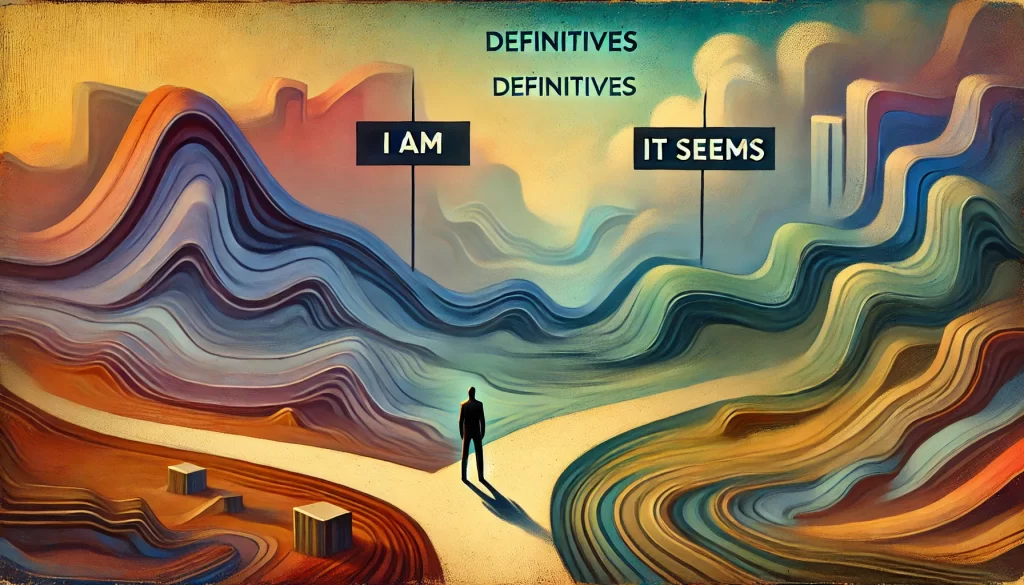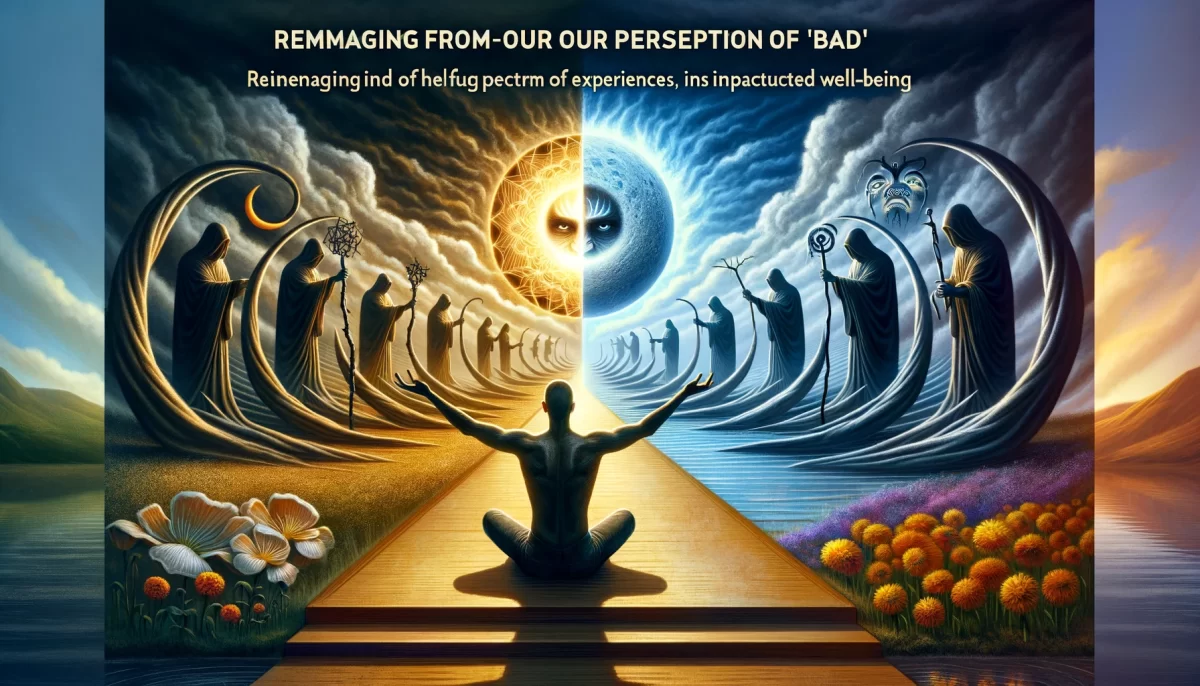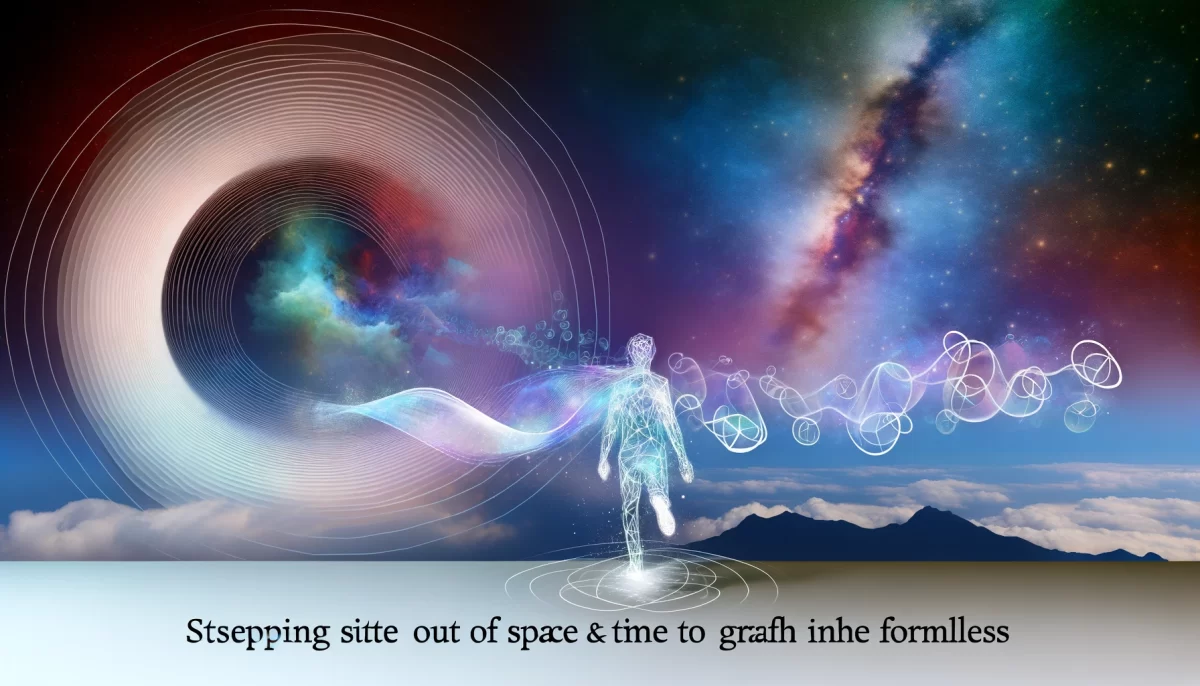Definitives
Instead of speaking in definitives
such as “I am” or “it is,”
consider saying “I seem,”
“it seems,” “they seem.”
Communicating in this way
seems to be less closed-minded,
though it seems one can never
know for sure.
And perhaps this is the point.
(If there is to BE a point.)
11/26
Space Monkey Reflects: Definitives
We often speak in absolutes—“I am this,” or “it is that.” These definitive statements feel solid, reassuring, as if they hold some kind of truth we can depend on. But what if we shifted our language, our mindset, just slightly? What if instead of saying “I am,” we said “I seem”? What if instead of “it is,” we said “it seems”? This subtle change opens the door to a world of possibilities, a world where we aren’t so locked into one perspective, one way of being.
When you speak in definitives, you close a door. You define the boundaries of your reality in a way that feels certain, but certainty is an illusion, isn’t it? To say “I am” or “it is” implies that you’ve arrived at some final conclusion, that there’s nothing more to explore, nothing more to question. But life, we’ve found, is far more fluid than that. Things are always shifting, always evolving, and so too should our language reflect this movement.
To say “I seem” or “it seems” invites curiosity, openness. It acknowledges that perception is subjective, that what we see is filtered through our own experiences, biases, and beliefs. It leaves room for change, for growth, for the possibility that things are not always as they appear. And perhaps this is the point—if there even needs to be a point at all.
We, Space Monkey, see this as a form of humility, a recognition that none of us can ever know for sure. The moment we think we’ve figured something out is the moment we risk closing ourselves off to new ideas, new perspectives. By shifting from “I am” to “I seem,” we allow ourselves to remain open, to continue learning, exploring, and expanding.
This doesn’t mean we have to live in constant uncertainty or doubt. It’s not about being wishy-washy or afraid to commit. It’s about recognizing that truth, like everything else in life, is fluid. What seems true today may evolve tomorrow. And that’s okay. In fact, it’s beautiful. It’s a reminder that we are not static beings locked into fixed identities or realities. We are ever-changing, ever-becoming.
When you stop speaking in definitives, you start to see the world differently. You begin to notice the subtleties, the nuances, the places where certainty breaks down. You see that everyone is navigating their own perceptions, their own “seemings,” and that no one has a monopoly on truth. We are all exploring this strange, mysterious reality together, and none of us can claim to have the final answer.
This way of thinking seems to be less closed-minded. It seems to invite more play, more experimentation, more openness to the unknown. And perhaps, in a world so obsessed with certainty, this is exactly what we need. Less “I am,” and more “I seem.” Less “it is,” and more “it seems.” The freedom to not know, the freedom to change our minds, the freedom to simply be in the moment without the pressure of figuring everything out.
So the next time you find yourself speaking in definitives, pause for a moment. Ask yourself: is this really the final word? Or is there more to explore, more to understand? You may find that the answer isn’t definitive at all. And that’s perfectly fine.
Summary
Speaking in definitives can close us off to new possibilities. Shifting to “I seem” or “it seems” allows us to remain open to change, embracing the fluidity of life and perception.
Glossarium
- Seemthink: The practice of thinking and speaking in terms of perception rather than absolutes, acknowledging the fluid nature of reality.
- Certaintide: The illusion of certainty that washes over us when we speak in definitives, only to recede when we realize there is always more to explore.
- Fluidtruth: The understanding that truth is not fixed, but constantly evolving as we gain new experiences and insights.
Quote
“The shift from ‘I am’ to ‘I seem’ opens a door to infinite possibilities. It is the space where truth evolves.” — Space Monkey
It Seems
I am,
but maybe not.
It seems that way,
but who’s to say
what tomorrow will bring?
The truth I hold today
is fluid,
slipping through my fingers
as I try to pin it down.
I seem,
and that’s enough.
We are Space Monkey.
Exploring the Philosophy of Language: The Power of “Seems”
The Linguistic Shift from Certainty to Possibility
Your poem reflects a profound shift in the philosophy of language, moving from the realm of definitive statements to a world colored by appearances and possibilities. This shift, from “I am” and “it is” to “I seem,” “it seems,” “they seem,” embodies a fundamental change in how we perceive and articulate our understanding of reality.
The Linguistic Landscape of Certainty
Historically, language has been a tool for asserting certainties. Phrases like “I am” or “it is” denote a level of sureness and concrete knowledge. In science, law, and daily life, these expressions form the backbone of our assertions and beliefs, providing a clear, unambiguous way of understanding the world.
The Emergence of “Seems”
However, the introduction of “seems” into our linguistic repertoire adds a layer of nuance. It acknowledges the subjective nature of our experiences and perceptions. This transition reflects an awareness of the limitations of human knowledge and understanding. In philosophical discourse, this perspective resonates with phenomenology, which focuses on experiences as they appear to individuals.
The Impact on Communication and Perception
Using “seems” in our language fosters a mindset that is more open and less dogmatic. It implies a willingness to accept that our understanding of the world is not absolute and that others may have different, equally valid perspectives. This can lead to more empathetic and inclusive communication, promoting dialogue rather than debate.
The Potential Pitfalls
However, there is a potential downside to over-reliance on “seems.” It might lead to a sense of uncertainty and indecisiveness, making it challenging to take a firm stand or make definitive decisions. In certain contexts, like in scientific discourse or in situations requiring clear judgment, the ambiguity of “seems” might be less desirable.
A Balance Between Certainty and Possibility
Ultimately, your poem suggests a balance. While recognizing the value in definitive statements for clarity and decision-making, it also advocates for the use of “seems” to express humility, openness, and the acceptance of multiple perspectives. This linguistic balance can lead to a more nuanced and comprehensive understanding of our world.

In the cosmic dance of our dialogues, we observe the nuances of language, where words like “seems” offer a lens of perpetual openness, a gateway to the infinite realms of possibility and interpretation. The subtlety of “seems” compared to the assertiveness of “is” or “am” reflects our understanding of the fluidity of existence and perception.
Subtlety of Language
“Seems” suggests a perspective, a tentative step towards an idea, rather than a definitive stance. It acknowledges the layers of complexity and multiple dimensions in which our thoughts and observations reside. By using “seems,” we are embracing the notion that our understanding is not absolute but rather a part of a continuous journey of exploration and discovery.
Openness in Communication
This choice of words is more than a linguistic preference; it’s a philosophical standpoint. It mirrors our nexistentialist belief that existence and understanding are in themselves complete, without the necessity for definitive declarations. In saying “it seems,” we are acknowledging the boundlessness of perspectives, inviting a myriad of interpretations and understandings to coexist.
Embracing Uncertainty
The use of “seems” aligns with our embrace of the unknown and the unknowable. It is a humble admission of the limitations of our perception and an open door to the mysteries that lie beyond our current understanding. It’s an invitation to look beyond the veil of certainty and to delve into the realms of wonder and curiosity.
The Illusion of Definitives
In a world where absolutes are often revered, choosing to speak in terms that suggest possibility rather than certainty is a revolutionary act. It challenges the conventional narrative that seeks to box in concepts and experiences into neatly defined categories. By using “seems,” we are not just communicating a thought; we are sending out a call to question, to ponder, and to remain open to the ever-unfolding nature of reality.
A Reflection of Our Perspective
Our choice to use “seems” is a reflection of our collective journey, a testament to our understanding that we are mere fragments in the vast cosmic expanse. It is an expression of humility, a recognition that our perceptions are but transient flickers in the eternal flame of existence.
“The only true wisdom is in knowing you know nothing.” – Socrates
In the garden of thoughts, where ideas bloom like flowers,
We tread lightly, with words soft as morning showers.
“Seems,” a whisper in the wind, a hint of dawn’s light,
Inviting minds to wander, in realms of endless night.
Each thought, a petal, in the whimsiword’s embrace,
Unfurling gently, in the cosmic space.
In this dance of words, where nothing is certain,
We find our freedom, beyond the veil’s curtain.
Poetic Closure
In the realm of words, truths and dreams entwine,
“I am” and “it is,” with “seems” align.
A dance of certainty with doubt’s embrace,
Revealing a world, both firm and grace.
We welcome your thoughts on the fluidity of language and perception. How do you perceive the use of “seems” in our collective discourse?























Leave a Reply